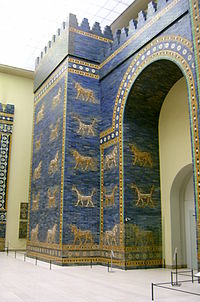Wikijunior:Ancient Civilizations/Babylonians
The Babylonians were an ancient civilisation that existed many years ago.
What country did they live in?[edit | edit source]
The Babylonians were based in what is now modern-day central Iraq (about 50-60 miles from Baghdad, Iraq). They controlled much of the land between the rivers the Tigris and the Euphrates. They were the last of a string of city states (civilizations based around a single powerful city) to control this area.
What did their buildings look like?[edit | edit source]

In the 24th century BC the city of Babylon was founded on the banks of the river Euphrates. In the 18th century BC it became a capital of Babylonian empire.
Babylon reached its glory in 6th century BC. Constructions like Ishtar Gate and Etemenanki ziggurat were built, making Babylon the most beautiful city of the ancient world.
Ishtar Gate was one of the eight gates of the Babylon city. Dedicated to the goddess Ishtar, the Gate was constructed of blue glazed tiles with alternating rows of relief dragons and bulls. The roof and doors of the gate were of cedar. Through the gate ran the Processional Way, which was lined with walls covered in lions on glazed bricks (about 120 of them). Statues of the gods were paraded through the gate and down the Processional Way each year during the New Year's celebration.

Processional Way led to Etemenanki ziggurat. A ziggurat was a pyramid like tower that they made for their gods. Etemenanki was seven stories, or 91 meters high, and had a temple of Marduk on top of it.
Ishtar Gate is currently displayed in Pergamon Museum in Berlin. Only ruins are left of Etemenanki ziggurat.
What did they eat?[edit | edit source]

The Babylonians ate melons, plums, prunes and dates. Barley was their staple crop that they would make flat breads with. The bread would then be eaten with some fruit. For meat they ate pork, poultry, beef, fish and mutton (sheep meat). Onions and garlic were common seasonings for their food. Babylonians didn't drink wine, but instead they drank beer made out of barley.
What did they wear?[edit | edit source]

Babylonians wore a garment that would look like a long T-shirt in our day. For the peasants these garments would have been quite simple but for the wealthy they were decorated with tassels, embroidery, girdles and sashes. Higher ranking people wore longer garments and scarves that indicated their rank by the length of its tassels.
Hats were also an important fashion accessory. Professionals could be identified by their characteristic headdress. Women wore ribbons, veils or other decorations in their hair.
What did their writing look like?[edit | edit source]

Babylonians spoke Akkadian, an ancient language. They used the cuneiform script for writing. Babylonian writing that still exists is all on clay tablets. The symbols of their script were pressed into the wet clay with a piece of dried reed.
Cuneiform is ancient way of writing. There were about 200-400 common characters that represented different syllables. For example, one symbol might represent the sound "bu" and another symbol would represent the sound "ba". There were also symbols that represented whole words.
What did they believe?[edit | edit source]
The Babylonians were polytheists; they believed that there were many gods that ruled different parts of the universe. They believed that the king god was Marduk, patron of Babylon. Just as Babylon conquered all city states and became the capital of a mighty empire, so, in the legend, its patron Marduk obtained power over other gods by fighting Tiamat, the evil goddess of chaos.
The Babylonians built each of their gods a primary temple that was considered the home of the god. People would bring sacrifices to the gods and the priests would try to attend to the needs of the gods through ceremonies and festivals. Each temple had an open temple courtyard and then an inner sanctuary that only the priests could enter. Sometimes special pyramid shaped towers, called ziggurats, were built to be a part of the temples. The top of the tower was special sanctuary for the god.
Babylonians believed that after death every soul went to the underworld. The underworld was considered a dark and dismal place. This made death a dreadful event as there was no hope of ever having anything better.
Are some of them famous even today?[edit | edit source]
One of Babylon's most famous kings was Hammurabi. He ruled for 43 years. Hammurabi is famous for creating one of the first formal written set of laws. These laws were written on a finger-shaped stone stele. or tablet, standing over six feet tall. The most famous rule he set is now known as an eye for an eye. This rule said that the punishment for lawbreakers would be the same as the crime they committed. So if a criminal stabbed a person in the eye, the criminal would be stabbed in the eye too. The laws he made were known as "The Code Of Hammurabi". This legal system was spread throughout Asia and Europe. The Code of Hammurabi is also interesting because it was the first set of laws which presumed people were innocent, meaning a person must be proven guilty before they could be punished for their crimes.
Nebuchadnezzar II is mentioned in The Bible (The Christian holy book), the Torah (The Jewish holy book) and the Qur'an (The Islamic holy book). He was a ruler of Babylon who destroyed the Jewish temples in Jerusalem.
What is left of them today?[edit | edit source]
The ruins of the city of Babylon still exist although the city has been abandoned for over 2000 years.
Many of the inventions of the Babylonians are still important today. They invented metalworking, copper-working, glassmaking, lamp making, textile weaving, flood control, water storage, as well as irrigation. Interestingly, from their number system we get our concept of there being 60 minutes in an hour and 60 seconds in a minute.